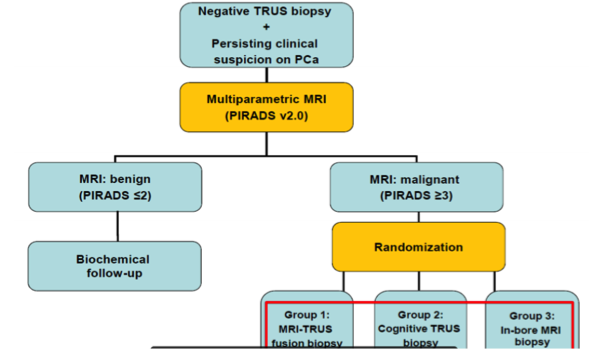For this trial, 642 men were recruited between 2014 and 2017 with prior negative prostate biopsies and a suspicion on prostate cancer (based on PSA≥4 and/or abnormal DRE) who underwent an mpMRI. Imaging was centrally evaluated by an expert radiologist using PIRADS v2. If mpMRI demonstrated PIRADS ≥3 lesions, patients were randomized 1:1:1 for MRI-targeted biopsy using one of the three aforementioned approaches. Overall prostate cancer and significant prostate cancer (Gleason≥7) detection rates were compared using the Pearson Chi square test.

There were 231 patients (36.0%) who had a PIRADS ≥3 lesion on mpMRI, and 223 underwent MRI-targeted biopsy. There were no significant differences in baseline characteristics, nor were PIRADS scores significantly different between the three groups (p=0.87).
Table: PIRADS scores stratified by MRI-targeted approach

Using cognitive TRUS biopsy, prostate cancer was detected in 44.0% of cases, and significant prostate cancer in 33.3%. Using MR-TRUS fusion biopsy, prostate cancer was detected in 49.3%, and significant prostate cancer in 33.3%. Using in-bore MRI biopsy, prostate cancer was detected in 56.2%, and significant prostate cancer in 34.2%. The detection rates of the three MRI-targeted techniques were neither significantly different for overall prostate cancer detection (p=0.33) nor for significant prostate cancer (p=0.99).
The authors concluded that based on the results of this multicenter RCT, there does not seem to be a significant advantage of one specific MRI-targeted biopsy technique for the detection of (clinically significant) prostate cancer following prior negative prostate biopsies.
Speaker: Olivier Wegelin, St. Antonius Hospital, Nieuwegein/Utrecht, The Netherlands
Co-Authors: Exterkate L, Somford D, Barentsz J, Leest Van Der M, Kummer A, Vreuls W, Bruin, De P, Bosch R, Melick, Van H
Written by: Zachary Klaassen, MD, Urologic Oncology Fellow, University of Toronto, Princess Margaret Cancer Centre, Twitter: @zklaassen_md, at the 2018 European Association of Urology Meeting EAU18, 16-20 March, 2018 Copenhagen, Denmark


